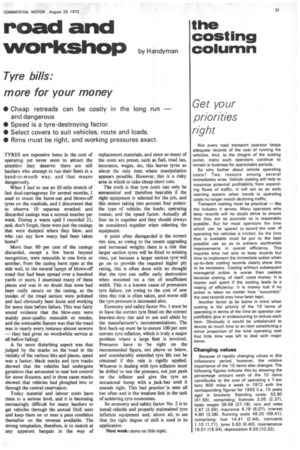the costing column
Page 33

If you've noticed an error in this article please click here to report it so we can fix it.
Get your priorities right
Not every road transport operator keeps adequate records of the cost of running his vehicles. And, to the chagrin of the costing purist, many such operators continue to remain in business for appreciable periods.
So why bother about vehicle operating costs? Two reasons among several immediately arise. Vehicle costing will help to maximize potential profitability from expanding flows of traffic. It will act as an early warning system when trends in operating costs no longer match declining traffic.
Transport costing must be practical — like the industry it serves. Many operators who keep records will no doubt strive to ensure that they are as accurate as is reasonably possible. But for most operators the time which can be spared to record the cost of operating his vehicles is limited. So the time that is available must be put to the best possible use so as to achieve worthwhile improvements in overall efficiency. This requires time not only to keep records but time to implement the immediate action when up-to-date costing records clearly show this to be necessary. Costing without subsequent managerial action is worse than useless because costing, of itself, costs money, It is money well spent if the costing leads to a raising of efficiency. It is money lost if no action is taken no matter how "accurately" the cost records may have been kept.
Another factor Lo be borne in mind when costing is the priority of the 10 items of operating in terms of the time an operator can justifiably give in endeavouring to reduce each item. Obviously it would be unbalanced to devote so much time to an item constituting a minor proportion of the total operating cost that little time was left to deal with major items.
Changing values
Because of rapidly changing values in this inflationary period, however, the relative importance of the 10 items also changes. The following figures indicate this by showing the percerrtage amount each of the 10 items contributes to the cost of operating a 7-ton lorry 600 miles a week in 1972 with the corresponding figures for 1963 (i.e. 10 years ago) in brackets: Standing costs: 53.80 (41.59), comprising: licences 3.05 (2.37), basic wages 39.09 (27.18), rent and rates 2.67 (2.59), insurance 4.19 (6.07), interest 4.80 (3.38). Running costs 46.20 (58.41), comprising: fuel 14.41 (2.44), lubricants 1.10 (1.71), tyres 5.63 (9.40), maintenance 16.01 (16.54), depreciation 9.05 (10.32).




















































































